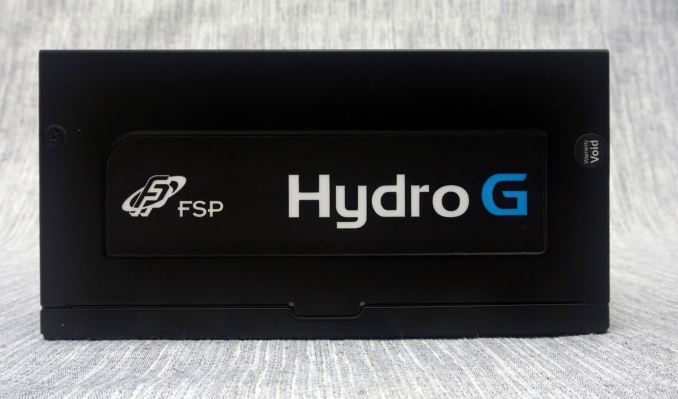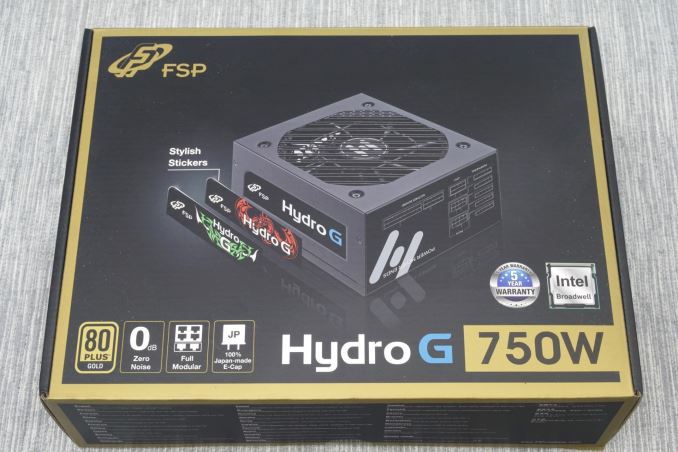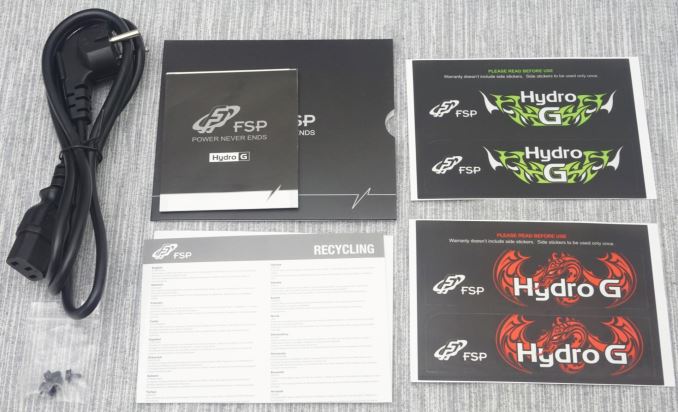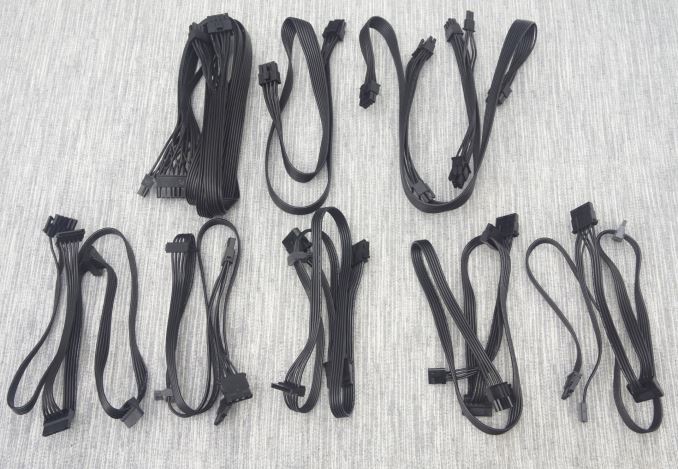The FSP Hydro G 750W Power Supply Review
by E. Fylladitakis on March 3, 2016 8:00 AM EST- Posted in
- PSUs
- Cases/Cooling/PSUs
- 750W
- FSP
- Modular

Fortron Source (FSP) is one of the oldest computer PSU manufacturers in the market, and is the OEM behind a number of rebranded products. Their designs are usually found in advanced mid-range units, such as the Be Quiet! Dark Power Pro 10 series, but FSP has also developed interesting high-wattage designs, some of which they have been selling under their own brand. To that end, today we'll be taking a closer look at one of thier first-party PSUs, the FSP Hydro G 750W.
FSP ranks their Hydro G as their premium series, albeit beneath the 80Plus Platinum certified Aurum PT units. The Hydro G series consists of three 80Plus Gold units, ranging from 650W to 850W. All three units are based on the same platform design and FSP has supplied us with the middle option, the 750W model, which should give us a good look at the quality and performance of the series. FSP is also boasting some interesting features that we are eager to examine, such as changeable side stickers, a "server grade" design and 0 dB(A) fan control.
| Power specifications ( Rated @ 50 °C ) | |||||
| AC INPUT | 100 - 240 VAC, 50 - 60 Hz | ||||
| RAIL | +3.3V | +5V | +12V | +5Vsb | -12V |
| MAX OUTPUT | 25A | 25A | 62.5A | 3.5A | 0.5A |
| 150W | 750W | 17.5W | 6W | ||
| TOTAL | 750W | ||||
Packaging and Bundle
FSP packs the Hydro G unit in a short but very sturdy cardboard box. The artwork is simple, based on a dark theme with golden edgings, with a picture of the PSU itself in the middle. The most important features of the PSU are presented on the front side of the box in the form of icons. Details may be found on its sides and rear.
Even though the Hydro G is considered a premium series by FSP, the company is supplying only the absolute basics with it. Inside the box we only found a standard AC power cable, four black mounting screws, and very basic manual/instructions leaflets. The PSU comes adorned with blue stickers, and as part of their color changing gimmick FSP also supplies sets of red and green stickers in the box to change the accent color of the PSU. The whole design of each set of stickers differs, not just the color. However it should be noted that these are true stickers rather than some kind of reusable solution, so once a sticker is applied that's it.
The modular cables of the Hydro G are "flat" ribbon-type cables, including the main 24-pin ATX cable. All of the wires and connectors are black. The number of connectors per cable is a bit unusual though. For example, one cable has four SATA connectors, another has two SATA and two Molex connectors, and two of them have two SATA, one Molex and one floppy connector each. There is no cable with just Molex connectors on it.
| FSP Hydro G 750W | ||
| Connector type | Hardwired | Modular |
| ATX 24 Pin | - | 1 |
| EPS 4+4 Pin | - | 1 |
| EPS 8 Pin | - | - |
| PCI-E 6+2 Pin | - | 4 |
| PCI-E 8 Pin | - | - |
| SATA | - | 10 |
| Molex | - | 6 |
| Floppy | - | 2 |













22 Comments
View All Comments
blahsaysblah - Thursday, March 3, 2016 - link
Not much seems to have changed with the actual PS design forever.PS + UPS in one(just a few minutes to shutdown safely and real surge protection and incoming voltage regulation).
PS combined with a CPU water cooler. They are usually in a key airflow spot in a lot of cases. Reduce noise and make it easier to keep cold air cold by combining two exhausts into one.
kaidenshi - Thursday, March 3, 2016 - link
"PS + UPS in one(just a few minutes to shutdown safely and real surge protection and incoming voltage regulation)."Indeed, I've never understood why we can't have a PSU/UPS combo in a full size PC, especially given the energy density of modern Lithium based rechargeable batteries. Maybe it's a safety issue? But then we've had Lithium batteries in laptops for about 20 years, that's a long time to perfect a design.
nathanddrews - Thursday, March 3, 2016 - link
I think you would both be interested in checking out some of the 5.25" battery backup units on the market. They are a bit niche and hard to find, but basically they are like what you are describing. The battery pack fits in a 5.25" drive bay and the PSU is connected through it.I think the main reason internal UPS aren't popular (outside the server market) is that desktop users have many other external devices connected that may also need to be powered down safely.
FuzionKore - Tuesday, March 8, 2016 - link
Exactly. Why invest in a PSU/UPS combo if your monitor dies anyways and you can't save what you were working on? The money is almost always better spent on a discrete UPS, unless somebody makes a unit with a power output for a monitor.5th element - Thursday, March 3, 2016 - link
Lithium ion batteries need to be kept cool otherwise their performance suffers quite badly. Inside a PSU is about the worst place you could put one.Wardrop - Friday, March 4, 2016 - link
How are you going to save your work and shutdown when your monitor is off? There's also often more to a PSU than just a battery. Adding all that to a PSU would make it quite expensive and extremely niche.Wardrop - Friday, March 4, 2016 - link
Replace the first "PSU" with "UPS".Murloc - Thursday, March 3, 2016 - link
a battery is pricey and useless to most people. What most people could use is a PSU able to survive a brown-out.But even then, it's probably more worth it to replace the PSU if something happens. I've had 1 PSU die on me in my whole life.
xenol - Monday, March 7, 2016 - link
If you're going to have a UPS anywhere, it should be at the mains. As another mentioned, what's the point if you can't see what you're doing?Also wouldn't want water anywhere near a PSU.
asmian - Thursday, March 3, 2016 - link
So it's called 'Hydro', but it's not water-cooled. Apart from generating click-bait product names, what on earth is their marketing team smoking?